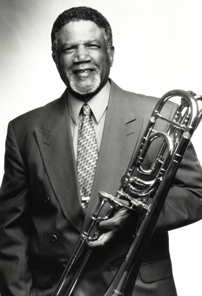The Count Basie Orchestra, now directed by trombonist Bill Hugdes,
and featuring Butch Miles on drums.
In 1947 Sy Oliver commented that "People were always talking about "Ghost Bands", asking me if I didn't think this was a Macabre. I knew Tommy {Dorsey}very well, and he's the last person who have wanted his music to die - he put too much into it. Too many people enjoyed it."
"Big Bands led by elderly men in the names of dead men are big business," Leonard Feathers, wrote in 1988, "While new bands played new and exciting music (such as Toshiko Akiyoshi Orchestra which won countless polls) having trouble getting three months work in a year."
The leader of the band may die leaving his melodies to linger on, with a so-called Ghost Band - that is, an ensemble that, following his death, bears his name and plays his music (and sometimes, newer music in his style), but is fronted by someone else.
The one exception to the rule was, for a long time, The Artie Shaw Orchestra, Artie Shaw was hardly a Ghost, living well beyond the 1983 formation of a new band using his name. And I don't intend to comply," he once quipped.
How ever the grim reaper eventually reached him, and he passed away in 2004 at the age of 94 before their deaths, certain leaders, including Benny Goodman, Stan Kenton and Wayne King specifically forbade any orchestras to carry under their name. Goodman remarked, "I absolutely don't want it.....anything under my name should be me. I am the product.
THERE WILL BE MORE ADDED
